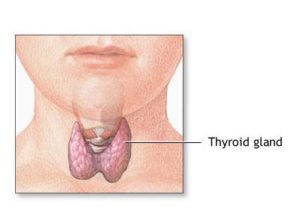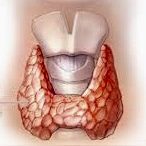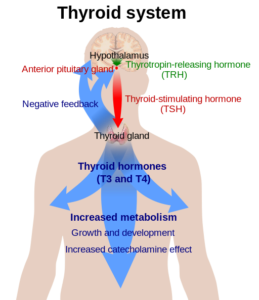What is a Thyroid gland and what does it do?
Thyroid gland is a butterfly shaped organ than sits at the base of the neck in front of the throat, it weighs about 25  grams in adults and has two lobes (left and right) with a connection in the middle. It uses iodine from diet to synthesize and secrete thyroid hormones (mainly T3 and T4) that regulate metabolism (the process of energy expenditure) in the body. These hormones are to the body what gasoline is to a car, without thyroid hormones metabolism slows down and eventually the body shuts down, sometimes resulting in coma if untreated.
grams in adults and has two lobes (left and right) with a connection in the middle. It uses iodine from diet to synthesize and secrete thyroid hormones (mainly T3 and T4) that regulate metabolism (the process of energy expenditure) in the body. These hormones are to the body what gasoline is to a car, without thyroid hormones metabolism slows down and eventually the body shuts down, sometimes resulting in coma if untreated.
The main vital body functions regulated by the thyroid hormone include:
- Body temperature
- Body weight and growth (especially in children)
- Heart rate & blood pressure
- Nervous system
- Hair and skin function
- Muscle strength and function
- Reproduction and Menstrual cycle
How is the thyroid gland regulated?
Thyroid function is primarily regulated by the hypothalamus and pituitary glands, located at the base of the brain. This regulation works in a negative feedback mechanism.
When there are low levels of thyroid hormone in blood the pituitary gland secretes thyroid-stimulating hormone (TSH) under the influence of Thyroid releasing hormone (TRH) from the hypothalamus. TSH then goes to the thyroid and stimulates it resulting in more thyroid hormones being secreted thus correcting the levels in blood. The opposite happens when there is too much thyroid hormone circulating in blood, the pituitary gland will decrease or even stop secretion of TSH in an effort to decrease the production of thyroid hormones.
It is this kind of regulation and changes in the endocrine system that allows a physician to check the function of the thyroid by measuring both thyroid hormones and TSH, especially TSH since it is very sensitive to changes in thyroid hormone levels.
.
Common Types of Thyroid Disorders
1. Hypothyroidism and Hashimoto’s Thyroiditis
Hypothyroidism is a state of underactive thyroid gland, meaning the gland simply can’t make enough thyroid hormone to maintain normal body functions and metabolism. The most common cause of hypothyroidism in iodine sufficient areas is Autoimmune Thyroiditis (Hashimoto) followed by; thyroidectomy (surgical removal of thyroid), radioactive iodine ablation of the thyroid (usually for treatment of hyperthyroidism), postpartum thyroiditis (inflammation of the thyroid after delivery), and other rare causes including drugs, congenital (from birth), infiltrating diseases and pituitary/hypothalamic disorders. Iodine deficiency is a cause of hypothyroidism and goiter in places where there is not enough iodine in diet, however this has become rare especially in most countries where there is adequate intake of iodized salt and foods rich in iodine.
Read more on Hypothyroidism and Hashimoto’s Thyroiditis
.
2. Hyperthyroidism and Grave’s Disease
Hyperthyroidism is a condition in which there is excessive production and/or secretion of thyroid hormone by the thyroid gland (overactive thyroid). Grave’s disease is the most common cause in the US and most countries. Other causes include; multinodular goiter, toxic adenoma, excessive intake of thyroid hormone, drugs (like iodine and Amiodarone), thyroiditis, excessive iodine load (ingestion or via intravenous contrast medium used in CT scans), and other less common ones like pituitary tumor producing thyroid stimulating hormone (TSH).
Graves disease
Graves disease is an autoimmune disease of the thyroid, named after an Irish physician Robert James Graves who described a case of goiter with eye involvement in the 19th century. This disorder is characterized by the immune system producing antibodies to the receptors of the thyroid resulting in stimulation and excessive production of thyroid hormones (overactive thyroid). This disease tends to be hereditary and can occur at any age, more common in females than males especially during the 2nd and 3rd decade of life.
Read more on Hyperthyroidism and Grave’s Disease
.
3. Goiter
Goiter is a term used to describe an enlarged thyroid. A goiter is usually associated with a thyroid that does not function well (either hypothyroidism or hyperthyroidism), however there are situations when goiter can be present in normal functioning thyroid as seen in areas where there is less iodine intake and also in a thyroid that has nodules. In most situations a goiter indicates that there is a condition present causing the thyroid to grow abnormally.
Read more on Goiter
.
4. Thyroid nodule
A thyroid nodule is an abnormal growth of thyroid cells forming a solid or fluid filled lump in the thyroid. There may be a single nodule or multiple nodules identified in the thyroid. After the age of 60 more than half of the general population has thyroid nodules, most of these nodules are benign (more than 90%) and just a few turn out to be cancerous. Besides some genetic causes of some thyroid cancers, the cause of these nodules is unknown. Hashimoto (hypothyroidism) can be associated with thyroid nodules and sometimes a nodular appearance as a result of chronic inflammation of the thyroid.
Read more on Thyroid nodule
.
5. Thyroid cancer
Thyroid cancer arises from cells within the thyroid gland, it is less common compared to breast, colon, lung and other types of cancers. Although it is less common in the United states and other countries, rates seem to be increasing especially over the past 20 years, partly due to increased early detection of small papillary thyroid cancers secondary to a widespread use of neck ultrasound and fine needle aspiration of thyroid nodules. Prevalence and incidence of thyroid cancer tends to be more in females than males at an estimated ratio of 2:1, most affected are between the ages of 40-60 years however thyroid cancer can develop at any age especially if there is an inherited genetic mutation.
Read more on Thyroid Cancer

